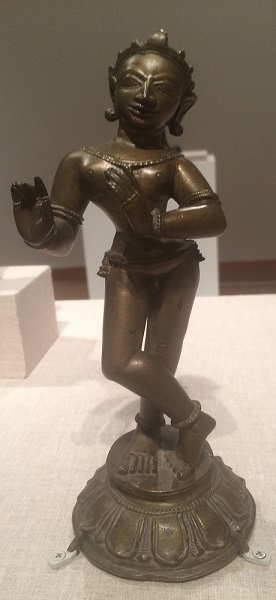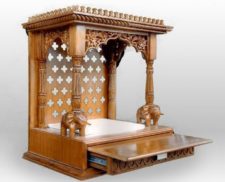
Unknown
Indian (active Odisha)
Krishna the Flutist Cowherd, 17th c. CE
bronze
7 3/4 x 3 1/2 x 3 1/4 in.
SBMA, Gift of Pratapaditya and Chitra Pal
2008.47.11
RESEARCH PAPER
Krishna, the eighth incarnation of Lord Vishnu, when he appeared in human form, belonged to the cowherd’s community of Braj, his birth place. At present this is in the area around Mathura, Uttar Pradesh, North India. In Braj the cowherds hold a stick, but Krishna holds a ‘venu’, a flute. Krishna, or Gopal who holds the venu, is known as Venugopal. This calm and serene image of Venugopal stands crossed legged, at the ankle on the round lotus pedestal. His facial expression and flute playing gesture gives an appearance that he also is immersed in the magical power of the music, which brings to his face a celestial glow. He is not wearing any garments, not even the lower garments called dhoti that appeared on other versions of these images. He is jeweled with simple ornaments such as a simple crown, as opposed to three tiered typical Orissa style crown, and earrings, necklaces called vaijantimala, bracelets, armlet, nice girdle, and anklets. The vaijantimala is made out of the fruit of the tree called vaijanti. Growing up krishna spent a lot of time under a vaijanti tree, and wore mala or a necklace made out vaijanti. It is believed that vaijanti brings peace and calmness to a person's body and life. Krishna and Lord Vishnu followers wear this mala and use it to count prayers or when chanting. It is a theological flower offered to Krishna and Vishnu in worship as a garland. "Vaijayanti-mala” literally means "the garland of victory". Krishna’s hair is tied neatly at the back. His sculpted body is almost perfect, like a true god should be. Sometimes large curved wooden figural groups were used to ornament large chariots taken on procession through the streets on festival days. Small bronze figures like this were placed in altars of temples or homes for prayer. In Hinduism, the altar is the primary center of worship. Altars are not only found in temples but in Hindu homes as well. The Hindu tradition is a tradition of the home, and the home altar is an important part of a Hindu household (illustrated below).
In the sixteenth century, under the reign of Muslim ruler emperor Akbar, who was sympathetic to Hinduism and Christianity as well as Islam, traditional Indian artists were exposed to the delicate and conventionalized miniatures of the great Persian artists. During the seventeenth and eighteenth centuries, art responded vigorously to the interplay between foreign modes at the imperial capital and local idioms at isolated feudal courts. Many delightful hybrids and innovations resulted - some delicate and lyrical, some stark and bold. The joyous exuberance of these new styles was particularly well suited to newer Hindu cults, which were dedicated to the worship of Krishna, an avatar of Vishnu.
Mythology
Krishna, in Sanskrit “Kṛṣṇa”, one of the most widely revered and most popular of all Indian divinities, was worshipped as the eighth incarnation (avatar, or “avatara”) of the Hindu god Vishnu and also as a supreme god in his own right. Krishna became the focus of numerous bhakti or devotional cults, which have, over the centuries, produced a wealth of religious poetry, music, and painting. The basic sources of Krishna’s mythology are the epic Mahabharata and its 5th-Century CE appendix, the “Harivamsha”, and the Puranas, particularly Books X and XI of the “Bhagavata-purana”.
Krishna, which literally means “black,” or “dark as a cloud”, belonged to the Yadava, a pastoral race, and the god’s birth is picturesquely described in the Mahabharata. One day Vishnu, the great Hindu god, pulled two hairs from his own head, one white and one black. The black hair was planted into the womb of Devaki, a princess of the city of Mathura, and so Krishna was born into the Pandava family, his earthly father being Vasudeva. Unfortunately for Krishna his mother’s brother, Kamsa, who was a tyrant ruler, had been warned that Devaki’s eighth child would kill him, so Kamsa determined to murder the eighth child, a crime he had already carried out seven times before Krishna was born. Fortunately, Vasudeva took some precautions, and Krishna was smuggled across the Yamuna River to Gokula (or Vraja, modern Gokul), where he was raised by the leader of the cowherds, Nanda, and his wife Yashoda. Krishna was brought up in the remote village of Vrindavana as a simple cowherd. In this guise he can be referred to as Govinda. There he spent an idyllic childhood, with the foster parents Nanda and Yashoda, his sister is Subhadra, and his brother Balaram.
The child Krishna was adored for his mischievous pranks; he also performed many miracles and slew demons. As a youth, the cowherd Krishna became renowned as a lover. The sound of his flute prompted the “gopis”, wives and daughters of the cowherds, to leave their homes to dance ecstatically with him in the moonlight. His favorite among them was the beautiful Radha, who became his favorite wife, with whom he had a son, Pradyumna, and daughter, Carumati. Tradition has it that the god actually acquired 16,108 wives and fathered 180,000 sons.
At length, Krishna and his brother Balarama returned to Mathura to slay the wicked Kamsa; after his beheading Krishna established himself as king of Mathura. Afterward, finding the kingdom unsafe, Krishna led the Yadavas to the western coast of Kathiawar and established his court at Dvaraka (modern day Dwarka, Gujarat). He married the princess Rukmini (who is considered Krishna’s second most favored wife after Radha) and took other wives as well.
Krishna refused to bear arms in the great war, the battle of Kurukshetra, between the Kauravas, sons of Dhritarashtra who was the descendant of Kuru, and the Pandavas, sons of Pandu. But he offered a choice of his personal attendance to one side and the loan of his army to the other. The Pandavas chose the former, and Krishna thus served as charioteer for the warrior prince Arjuna, one of the Pandava brothers. It was on the eve of this battle that Krishna recounted the sacred song of the Bhagavad Gita to Arjuna. Within this song Lord Krishna highlighted that the self is quite separate from the body and continues throughout time: ‘Never was there a time I did not exist, nor you, nor all these kings; nor in the future, shall any of us cease to exist’ (Bhagavad Gita). It is in the Bhagavad Gita that Krishna also stated that ‘All this universe has been created by me; all things exist in me’. Arjuna, in the same work, tells us that Krishna is ‘divine, prior to the gods, unborn, omnipresent’.
In other adventures Krishna built the great fortress city of Dvaraka in Gujarat, known as the ‘City of Gates’. Seven days after a brawl broke out one day among the Yadava chiefs in which Krishna’s brother and son were slain. As the god Krishna sat in the forest lamenting, a huntsman, mistaking him for a deer, shot him in his one vulnerable spot, the heel, killing him. Dvaraka was submerged beneath the ocean after his death.
Krishna has dual role as the punisher of human deeds but also as a bringer of enlightenment. Thus the story of Krishna contains a double concealment. Krishna is both a god disguised as a mortal and a prince disguised as a commoner. Accordingly, the myths contain many metaphors of disguise, such as a spark within a pile of ashes or a mighty sword in its scabbard, and these hint at Krishna's dual purpose as the punisher of human deeds and as a bringer of enlightenment.
Krishna’s personality is clearly a composite one, though the different elements are not easily separated. Vasudeva-Krishna was deified by the 5th Century BCE. The cowherd Krishna was probably the god of a pastoral community. The Krishna who emerged from the blending of these figures was ultimately identified with the supreme god Vishnu-Narayana and, hence, considered his avatar. His worship preserved distinctive traits; chief among them was an exploration of the analogies between divine love and human love. Thus, Krishna’s youthful dalliances with the “gopis” are interpreted as symbolic of the loving interplay between God and the human soul.
Worship & Representation in Art
The worship of Krishna may have started as early as the 5th Century BCE. Today he is worshipped as the supreme Hindu god by many believers, and he is especially revered in Bengal and Udupi in southern India. One of the many festivals held in his honor is the ratha-yatra chariot festival in Puri which commemorates Radha’s successful attempt to persuade Krishna to return to Vrindavana. Perhaps the most widely observed festival is the Krishna Janmashtami in mid-August to early September, which involves devotees fasting for 24 hours, offering milk sweets to the baby Krishna, and at midnight lighting wicks soaked in ghee (purified butter) in the ritual known as arati.
Krishna is typically portrayed in Hindu art with a dark skin, usually blue-black, and he may carry the cakra discus Vajranabha and the club Kaumodaki, both given to him by Agni. He typically wears a yellow robe, has a peacock feather in his long black hair, and commonly plays a flute. In reference to his occupation as a cowherd in his youth, Krishna is often accompanied with cows. In Khmer art the most popular scene of Krishna’s adventures is the lifting of Mt. Govardhana, and the god is frequently represented in the architectural sculpture at such famous sites as Angkor Wat.
Prepared for the Santa Barbara Museum of Art Docent Council by Sarajum Quazi, June, 2019.
Bibliography
Cartwright, Mark. Krishna. 01 October 2015. https://www.ancient./Krishna/
Gerdener, Helen. Art Through the Ages. 1996. Orlando, Florida. Harcourt Brace & Company. Tenth edition. p. 484.
Anon. Arjuna During the Battle of Kurukshetra. 04 September 2013. https://www.ancient.eu/image/1414/arjuna-during-the-battle-of-kurukshetra/

Hindu home altar
